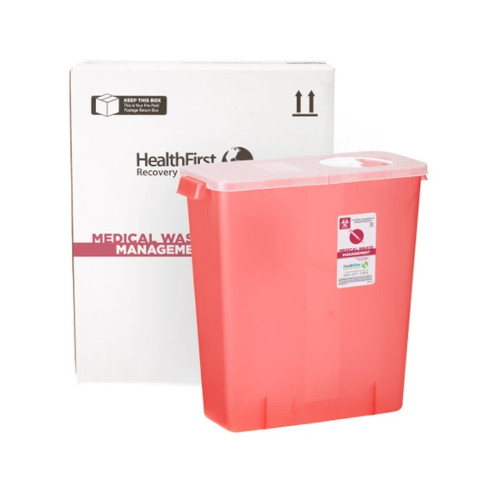Specialist Solutions for Health: Unveiling the Medical Waste Removal Service Advantage
Wiki Article
Exploring Different Waste Disposal Options for a Cleanser Atmosphere
In the search of a cleaner atmosphere, the monitoring of waste disposal has become a vital focal factor for lasting growth. With a multitude of waste disposal choices offered, ranging from typical land fill approaches to innovative waste-to-energy innovations, the selection of just how we manage our waste has significant effects for our earth's health. By analyzing the different methods and strategies employed in recycling, composting, incineration, landfill management, and waste-to-energy procedures, a deeper understanding of their impacts and effectiveness can be acquired. The mission for optimum waste disposal techniques that prioritize environmental preservation while satisfying the demands of an expanding population remains a pressing concern in today's world.Recycling Approaches
Executing effective reusing methods is critical in reducing waste and advertising sustainability in our setting. Recycling includes the procedure of transforming waste products into recyclable things to avoid unnecessary disposal.An additional vital recycling approach is composting, which includes decaying organic waste like food scraps and lawn trimmings into nutrient-rich dirt. By integrating these various recycling approaches into our waste administration methods, we can substantially decrease our ecological impact and move in the direction of a much more sustainable future.

Composting Strategies
Effective waste monitoring practices, such as reusing methods, lead the way for a cleaner setting, and now, moving the emphasis to 'Composting Techniques', we explore lasting ways to decay organic waste for ecological benefit. medical waste disposal.Composting is a natural procedure that transforms organic waste, like food scraps and yard trimmings, right into a nutrient-rich soil modification. The secret to effective composting depends on creating the best equilibrium of environment-friendly materials, such as vegetables and fruit scraps, and brown materials, like dried out branches and leaves. These materials decay with the aid of microorganisms, breaking down the waste right into important compost.
There are different composting techniques offered to suit different needs. Standard yard composting includes layering organic materials in a bin or stack and regularly transforming the mixture to aerate it. Vermicomposting, on the other hand, utilizes worms to damage down natural matter into garden compost (click here). For those with minimal area, indoor composting systems give a practical service. By utilizing composting techniques, we can lower the amount of waste sent out to garbage dumps while creating a useful product for improving soil and supporting plant development.
Incineration Benefits And Drawbacks
Incineration, as a waste disposal technique, provides both benefits and drawbacks that merit mindful factor to consider in the realm of sustainable waste monitoring techniques. On the silver lining, incineration can substantially minimize the volume of waste, lessening the requirement for landfill space and potentially reducing greenhouse gas discharges. Incineration additionally permits the healing of power through the generation of electricity or heat, contributing to resource recovery. Additionally, the process can be made use of to ruin hazardous substances, offering a secure approach for handling certain sorts of waste that may pose threats to public wellness and the atmosphere if left neglected.Furthermore, the high first financial investment and operational costs of incineration centers posture economic obstacles, making it a less affordable choice contrasted to other waste management approaches. Cautious monitoring and guideline are essential to mitigate these adverse influences and optimize the benefits of incineration as component of a comprehensive waste management approach.
Land Fill Management Methods
Garbage dumps play a critical duty in waste management and environmental conservation by offering a control system for the disposal of strong waste products. By compacting the waste, the volume is lowered, enabling for even more waste to be suited over time.Furthermore, the execution of daily cover methods is important in minimizing odors, preventing clutter, and minimizing the attraction of bugs. Covering the disposed waste at the end of each day aids to consist of smells and protect against prospective environmental contamination. Furthermore, the monitoring of land fill gas discharges and leachate degrees is crucial in making certain that environmental criteria are satisfied and that any kind of prospective risks to bordering ecosystems are decreased.

Waste-to-Energy Technologies
One of the innovative approaches to lose monitoring includes harnessing Waste-to-Energy modern technologies to convert strong waste right into useful energy sources. Waste-to-Energy (WtE) technologies incorporate a variety of procedures that aim to draw out energy from waste materials via thermal, chemical, or organic methods. This conversion procedure not just minimizes the quantity of waste that finishes up in land fills yet additionally generates beneficial power sources such as electrical energy, warmth, or biofuels.There are several approaches of Waste-to-Energy conversion, consisting of gasification, incineration, and pyrolysis. Incineration involves melting waste at heats to produce heat and electricity. Gasification transforms waste into a syngas, which can be used for power generation or chemical manufacturing. Pyrolysis breaks down natural materials utilizing heats in the absence of oxygen, creating char, gas, and bio-oil.
Implementing Waste-to-Energy technologies can aid alleviate environmental issues associated with traditional garbage disposal approaches while simultaneously giving a renewable resource source. Careful consideration has to be given to discharges control and making certain the sustainability of feedstock materials for these modern technologies to be truly helpful for a cleaner environment.

Conclusion
Finally, discovering various waste disposal choices such as reusing, composting, incineration, land fill monitoring, and waste-to-energy technologies is vital for advertising a cleaner setting - click here. Each technique has its own benefits and challenges, however by making use of a combination of these techniques, we can work in the direction of decreasing the amount of waste that winds up in landfills and inevitably add to a more lasting future for generations to comeWith a wide range of waste disposal alternatives offered, ranging from traditional land fill approaches to ingenious waste-to-energy technologies, the selection of just how we handle our waste has far-reaching effects for our world's wellness. medical waste disposal.Incineration, as a waste disposal technique, provides both advantages and drawbacks that merit careful consideration in the realm of sustainable waste management practices.Landfills play an important function in waste administration and environmental conservation by offering a containment system for the disposal of strong waste products. By compacting the waste, the quantity is reduced, permitting for even more waste to be accommodated over time
One of the innovative strategies to lose administration involves utilizing Waste-to-Energy innovations to convert strong waste right into usable power resources.
Report this wiki page